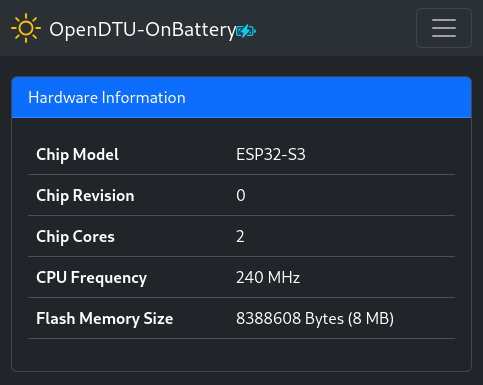Upgrade to 2024.08.18 or newer
Upgrading from OpenDTU-OnBattery version 2024.06.03 or older to versions 2024.08.18 or newer requires physical access to the ESP32 board. The new firmware (factory image including new partition layout) must be written to flash using the board's USB connection. This is a one-time operation, and newer versions can again be upgraded over-the-air (OTA), unless you continue to use an ESP32 with 4 MB of flash memory. Writing the factory image will preserve the configuration (do not erase the flash beforehand, just write the factory firmware binary).
Steps
- Download one backup of each your
config.jsonandpin_mapping.json, see Settings --> Config Management in OpenDTU-OnBattery's web application to prepare yourself if something should go wrong. - Determine the firmware variant (PIO Environment) you are currently using, see Info --> System.
- Determine the new firmware variant to use for your device, see below.
- Flash the factory firmware image using the USB connection of your board. Do not erase the whole flash memory beforehand. The flash tool of your choice will only erase the parts of the flash memory that will be overwritten.
- The update should be installed and your device should boot normally using the new firmware and using the existing settings.
New Firmware Variant
Which firmware variant you should use going forward depends on your board (MCU type and amount of flash memory).
In case you need to first determine how much flash memory is actually available on your board, install OpenDTU-OnBattery 2024.06.03 and navigate to Info --> System in the web UI. It lists the flash memory size in section "Hardware Information".
Coming from generic or generic_esp32
- Use
generic_esp32_4mb_no_otaif your ESP32 has only 4 MB of flash memory. You will lose the ability to install OTA updates. Install future updates by writing a new factory firmware image using the USB connection. - Use
generic_esp32_8mbif your ESP32 has at least 8 MB of flash memory. Attempting to write this onto a device with 4 MB of flash results in a bootloop.
If you are coming from generic see the migration
guide to configure the wiring to your NRF24 module.
Going forward, there will be no pre-built firmware release with compiled-in
pin mappings, i.e., there is no equivalent variant to generic.
Coming from generic_esp32s3 or generic_esp32s3_usb
The firmware is named the same, but it is now only compatible with devices having 8 MB or more of flash memory. Attempting to write this onto a device with 4 MB of flash results in a bootloop.
If you are actually on an ESP32-S3 with 4 MB of flash (should be quite exotic)
and need a matching firmware image, then open an
issue. Similar to
generic_esp32_4mb_no_ota there will be no support for OTA updates and you
will have to upgrade using a wired connection going forward.
Coming from Another Variant
As these variants are custom-build, you should know what you are doing. Variants for devices with only 4 MB of flash use the partition layout without OTA support. Other variants use the new layout for 8 MB of flash memory.
Downgrading
Configuration
After downgrading, you should upload a configuration backup created before upgrading. Downgrading is not supported in general. Some settings might revert to default values after downgrading.
4MB flash
Downgrading a device with 4MB of flash requires writing the older factory binary using a wired connection as changing the firmware over-the-air is not supported, neither for updates nor for downgrades.
Once you installed a factory firmware binary (2024.08.18 or newer) using a wired connection, you may downgrade to an older version using the over-the-air mechanism. This works because the partition layout can now handle all released firmware sizes.
Background
To accommodate a larger firmware binary, the ESP32 flash memory partition layout
changed with the release of OpenDTU-OnBattery version 2024.08.18. All firmware
released since then uses this new partition layout. Firmware variants generic
and generic_esp32 are no longer available.
- Partitions
otadataandnvsare not drawn in this graph. They remain unchanged. - The
spiffspartition was not moved in order to preserve the config and pin mapping when upgrading. Factory firmware images include data up to and includingapp0, i.e., when writing these images, thespiffspartition is neither erased nor overwritten. - Both older firmware partitions were merged, doubling the space available for
the first firmware partition
app0. - The second firmware partition
app1starts after thespiffspartition and has the same size as the first firmware partitionapp0. - The whole partition layout now spans close to 8 MB of flash memory.
- ESP32 with 4 MB of flash memory using the
generic_esp32_4mb_no_otavariant use the same new layout except that there is noapp1partition. This is why there is no support for OTA updates when using this partition layout. This layout does, however, fit 4 MB of flash while also accommodating more space (the same amount as for devices with ≥ 8 MB) for the firmware.
See #1025 for more background information.
Exception for ESP32-S3
You may flash the non-factory firmware image version 2024.08.18 or 2024.09.11 over-the-air onto an ESP32-S3 board, i.e., without updating the partition layout. This works as the firmware is slightly smaller for an ESP32-S3 as it is for an ESP32. Only the two releases listed above still fit the old partition layout for ESP32-S3. An attempt to write an image that is too large using OTA will fail gracefully. You will then need to upgrade the partition layout by flashing the factory image using the USB connection to continue upgrading.

